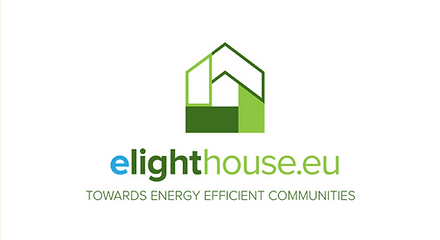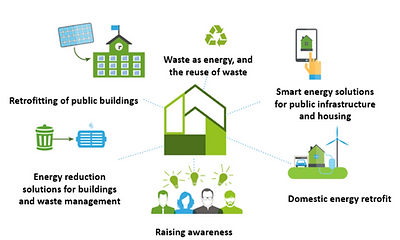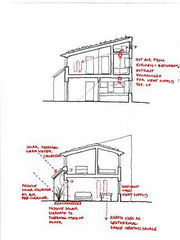
EUROPEAN PROJECTS
CHA believes in the importance of being a member of the European Union and the benefits this brings to the citizens of Ireland. Since 2001 we have been involved in a number of European projects with Partners from around the EU and beyond. These projects are important opportunities to learn from social housing best practice in other regions as well as sharing our own knowledge and experiences.
Jan 2019-Sep 2023: RED WoLF
(Rethink Electricity Distribution Without Load Following)


The RED WoLF project, funded by the EU programme Interreg North-West Europe (NWE), brings together 14 Partner Institutions from UK (5), France (4), Ireland (3), Belgium (1) and Germany (1). Universities, housing associations, local authorities as well as training and other non-profit organisations across North-West Europe aim to tackle housing emissions, responsible for approximately 300 million tonnes of CO2/year.
RED WoLF at CHA
The RED WoLF project will increase renewables' usage and reduce carbon emissions for homes with photovoltaic solar panels that do not have gas. CHA homes will provide one of six pilots in Ireland, UK and France. As part of this, CHA and Partners will fit houses with hybrid storage systems merging batteries and storage heaters. The heaters will provide heat on demand and the batteries will store output from the solar panels as well as low-carbon energy (wind/solar) drawn from the national grid at times of low demand using new 'smart' technology through which the houses hybrid storage systems will be able to communicate with the grid. This will remove the mismatch between generation and usage.
Cutting-edge innovation
Although solar panels, batteries and thermal storage currently exist, they are not systematically combined in homes. Storage will become affordable by combining batteries with a cheap heat storage technology. This will in turn enable homes with solar panels to use their energy locally, as well as to store grid electricity when nobody wants it. Negotiations with utilities will be aimed at achieving a reduced tariff for this service.
A home control system automatically makes decisions on storage based on local energy usage, the price of electricity, weather forecasts and the grid’s current CO2 intensity.
Avoid generation usage mismatch
One the one hand, there are times when a proportion of available renewable energy is wasted – it is being generated but no one uses it. On the other hand, there are certain times of day where energy demand is highest - from approximately 6 AM to 9 AM (when people are getting up and having breakfast) and from 4 PM to 8 PM (when they are home and getting the dinner on). At these times, demand is too high to rely on renewables alone so inefficient, carbon-intensive” load-following” power plants are turned on to meet the demand.
Why is CHA doing this?
It is clear now that Ireland and the world are facing a Climate Emergency, where every community organisation and everyone else has to do what they can to reverse this trend. Across the six pilot sites in UK, Ireland and France, there will be 100 houses which will reduce carbon emissions from their energy use by 215 tonnes/year. By the end of the project in 2022, the smart hybrid storage systems will be market-ready and prepared to be installed into NWE homes. CHA is proud to be a major pilot for this much needed response.
RED WoLF Partners
Lead Partner:
Project Partners:
-
Oldham Metropolitan Borough Council, Wakefield and District Housing Limited, National Union of Students of the United Kingdom and First Choice Homes (UK)
-
University of Lorraine, Électricité de France, Neolia and Campus de l’Espace (FR)
-
Institute of Technology Sligo, Cork City Council and Carbery Housing Association (IE)
-
Volta (BE)
-
GLAS Energy Technology (IE)
Officially approved in January 2019, the project was originally intended to end in July 2022. However, due to Covid the project was extended to September 2023.
The total budget received from Interreg North-West Europe (2014-2020) is €3.64 million of European Regional Development Fund (ERDF). The total project budget is €6.06 million.
For up-to-date information, please visit the Project website http://www.nweurope.eu/projects/project-search/red-wolf-rethink-electricity-distribution-without-load-following/ or follow the Project on Twitter or LinkedIn.
Apr 2016-Jun 2019: e-Lighthouse
(Energy Saving Lighthouse Cities in the NPA region)
The elighthouse project supports actions that increase energy efficiency in buildings and the uptake of renewable energy, thus decreasing carbon dioxide emissions. CHA became involved in the project through Partners NCE, who asked them to be Pilot Projects for two innovative models, the Sustainable Energy Community Model and the the Domestic Energy Management System.


-
Pilot Project on 5 domestic properties – using CHA properties purchased through the Mortgages to Rent Scheme.
-
CHA has set up an energy monitoring/ management system whereby we can monitor energy usage within each property.
-
Our plan is to improve energy management in all the properties, so we can get accurate energy usage readings.
-
When resources are available we will carry out a Deep Retrofit of each property.
-
The energy monitoring system will allow us to gauge the true savings from the retrofitting.
The Energy Monitoring System will:
A. Provide a calculation of overall energy use
B. Segregate the key appliances such as hob, oven, fridge, dishwasher, washing machine and dryer and provide energy use calculation for each
C. Identify standby loads.
D. Measure electricity generated (if any).
The Aims of the Energy Monitoring System:
A. To advise residents on actions that could improve energy behaviour and reduce energy bills such as changing times of energy using activities, changing suppliers to reduce costs, upgrading appliances and reducing standby loads.
B. To establish the real savings arising from retrofitting.
C. To establish the actual energy generated by renewables installed.
The e-Lighthouse project proved to be a successful 3-year long journey, full of great meetings, seminars and actions. We
did the work well, enjoyed meeting partners and friends bi-annually and really great time together. We also had
ambitious project goals which were achieved.
For more information on the project, visit the website here: http://elighthouse.eu
May-Mar 2002: RENEASE
(Renewable Energy Against Social Exclusion)
This Project ran from May 2002 to March 2003. The aim of the Project was to develop a model for design of sustainable social housing, creating a convergence between social and environmental objectives. This has been achieved. The Pilot Project has clearly demonstrated to a large constituency that added value could be gained from incorporating sustainable energy considerations into social housing development strategies.
The following results proposed in the RENEASE Project approved by the Commission have been achieved:
-
3 potential sites for new social housing settlements have been identified, and were submitted to Cork County Council for Planning Approval.
-
3 Planning Applications made for a total of 37 homes and a community facility based on bio-climatic design principles and renewable energy use. These incorporated solar orientation, super-insulation, thermal mass use, geo-thermal energy, as well as other aspects of sustainable design.
-
Detailed house design, in direct consultation with prospective residents and/or their representatives, was developed for the 37 homes and community facility applied for.
Cork County Council planners have rejected all 3 applications. One (in Sherkin Island, West Cork) was appealed to An Bord Plenala and lost. The viability of the design concept for social housing has been established on the basis of professional cost estimates that demonstrate that such construction is possible within the cost limits allowed by the DoEH&LG for social housing.
Download RENEASE final report here.
For RENEASE Sites Investigated for Feasibility for Social Housing click here.
January 2003 to end of December 2004: ECSA Project
(Enhancing Common Strategic Approaches)




The main purpose of this Project was to be the transfer of knowledge and best practises among territories in the filed of integration of housing and employment objectives.
1) Transnationally
CHA participated in all transnational exchanges carried out by ECSA, over a two-year period. Exchange events included officers of the County Council. These discussions and exchanges were reported back on a monthly basis to the Executive Committee of the Association, which was fully involved at every stage in the progress of the Project.
CHA participated actively in the Elaboration Committee charged with responsibility of defining the Criteria for best practise. CHA secured the active participation of Cork County Council, through a delegated executive officer, who contributed this Authority’s significant experience of the different items under consideration. In addition to this, CHA representatives carried out research into the Irish housing and employment sector, in order to allow a fuller understanding by all Partners of the Irish experience.
Common indicators were agreed and local strategies and actions in housing and employment were analysed and evaluated in the light of these indicators. On the basis of an analysis of the local situation and a comparative discussion of situations in other regions, CHA (and Cork County Council) participated in discussions and exchanges, which illustrated the various issues under consideration.
CHA also contributed to the development of a common strategy and helped in the identification of best practise in its own regional context, as well as suggesting best practise in the context of other Partners,
2) Locally
The development of Indicators for integrated and sustainable development of housing and employment were reported to the Executive Committee of CHA as they developed. At an early stage, the Executive Committee of CHA agreed that it would in future apply these indicators to its own social housing development projects, and would seek to integrate the indicators agreed to it.
Download: ECSA Final Technical Report (Year 2)















